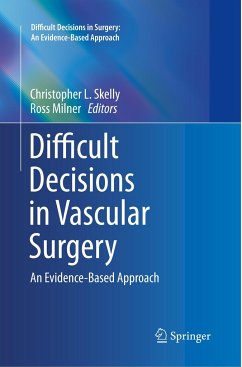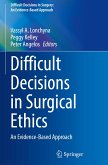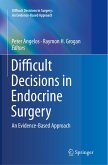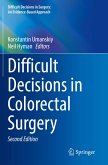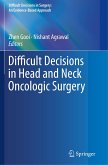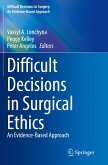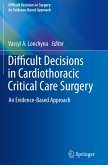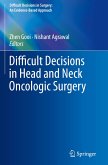Difficult Decisions in Vascular Surgery
An Evidence-Based Approach
Herausgegeben:Skelly, Christopher L.; Milner, Ross
Difficult Decisions in Vascular Surgery
An Evidence-Based Approach
Herausgegeben:Skelly, Christopher L.; Milner, Ross
- Broschiertes Buch
- Merkliste
- Auf die Merkliste
- Bewerten Bewerten
- Teilen
- Produkt teilen
- Produkterinnerung
- Produkterinnerung
This book looks at specific vascular surgery questions that have arisen and where careful analysis is given according to the level of supporting evidence available. As new technology is introduced to treat the cardiovascular system, alternative therapies begin to challenge and also complement traditional vascular surgery. All chapters contain the PICO table to summarise specific characteristics relative to the questions posed in each chapter.
Difficult Decisions in Vascular Surgery- An Evidence-Based Approach is a current and timely reference source for practicing surgeons, surgeons in…mehr
Andere Kunden interessierten sich auch für
![Difficult Decisions in Surgical Ethics Difficult Decisions in Surgical Ethics]() Difficult Decisions in Surgical Ethics173,99 €
Difficult Decisions in Surgical Ethics173,99 €![Difficult Decisions in Endocrine Surgery Difficult Decisions in Endocrine Surgery]() Difficult Decisions in Endocrine Surgery97,99 €
Difficult Decisions in Endocrine Surgery97,99 €![Difficult Decisions in Colorectal Surgery Difficult Decisions in Colorectal Surgery]() Difficult Decisions in Colorectal Surgery106,99 €
Difficult Decisions in Colorectal Surgery106,99 €![Difficult Decisions in Head and Neck Oncologic Surgery Difficult Decisions in Head and Neck Oncologic Surgery]() Difficult Decisions in Head and Neck Oncologic Surgery104,99 €
Difficult Decisions in Head and Neck Oncologic Surgery104,99 €![Difficult Decisions in Surgical Ethics Difficult Decisions in Surgical Ethics]() Difficult Decisions in Surgical Ethics116,99 €
Difficult Decisions in Surgical Ethics116,99 €![Difficult Decisions in Cardiothoracic Critical Care Surgery Difficult Decisions in Cardiothoracic Critical Care Surgery]() Difficult Decisions in Cardiothoracic Critical Care Surgery128,99 €
Difficult Decisions in Cardiothoracic Critical Care Surgery128,99 €![Difficult Decisions in Head and Neck Oncologic Surgery Difficult Decisions in Head and Neck Oncologic Surgery]() Difficult Decisions in Head and Neck Oncologic Surgery157,99 €
Difficult Decisions in Head and Neck Oncologic Surgery157,99 €-
-
-
This book looks at specific vascular surgery questions that have arisen and where careful analysis is given according to the level of supporting evidence available. As new technology is introduced to treat the cardiovascular system, alternative therapies begin to challenge and also complement traditional vascular surgery. All chapters contain the PICO table to summarise specific characteristics relative to the questions posed in each chapter.
Difficult Decisions in Vascular Surgery- An Evidence-Based Approach is a current and timely reference source for practicing surgeons, surgeons in training, and educators, that describes the recommended ideal approach, rather than customary care, in selected clinical situations.
Difficult Decisions in Vascular Surgery- An Evidence-Based Approach is a current and timely reference source for practicing surgeons, surgeons in training, and educators, that describes the recommended ideal approach, rather than customary care, in selected clinical situations.
Produktdetails
- Produktdetails
- Difficult Decisions in Surgery: An Evidence-Based Approach
- Verlag: Springer / Springer International Publishing / Springer, Berlin
- Artikelnr. des Verlages: 978-3-319-81478-0
- Softcover reprint of the original 1st ed. 2017
- Seitenzahl: 544
- Erscheinungstermin: 9. Juni 2018
- Englisch
- Abmessung: 235mm x 155mm x 28mm
- Gewicht: 914g
- ISBN-13: 9783319814780
- ISBN-10: 3319814788
- Artikelnr.: 53571291
- Herstellerkennzeichnung Die Herstellerinformationen sind derzeit nicht verfügbar.
- Difficult Decisions in Surgery: An Evidence-Based Approach
- Verlag: Springer / Springer International Publishing / Springer, Berlin
- Artikelnr. des Verlages: 978-3-319-81478-0
- Softcover reprint of the original 1st ed. 2017
- Seitenzahl: 544
- Erscheinungstermin: 9. Juni 2018
- Englisch
- Abmessung: 235mm x 155mm x 28mm
- Gewicht: 914g
- ISBN-13: 9783319814780
- ISBN-10: 3319814788
- Artikelnr.: 53571291
- Herstellerkennzeichnung Die Herstellerinformationen sind derzeit nicht verfügbar.
Christopher L. Skelly, MD FACS Associate Professor of Surgery, Chief of Vascular Surgery & Endovascular Therapy; Director of Vascular Surgery Fellowship Program and Director of Vascular Lab. Christopher Skelly, MD specializes in vascular surgery. He performs a full range of open and endovascular procedures, including the treatment of carotid disease, complex aortic pathologies and peripheral vascular disease. In addition, he performs minimally invasive surgery for the treatment of median arcuate ligament syndrome. In addition to his clinical practice, Dr. Skelly directs a research laboratory aimed at improving outcomes and durability of vascular graft repairs. As a 2008 recipient of the NHLBI Jointly Sponsored Mentored Clinical Scientist Development Award, his research is funded by the American Vascular Association (AVA)/American College of Surgeons (ACS) and the National Heart, Lung and Blood Institute (NHLBI). Dr. Skelly has authored more than 35 scientific articles in peer-reviewed journals, and several book chapters and reviews. He is working on numerous clinical trials, including a below-knee arterial bypass trial, for which he serves as site-principal investigator. Ross Milner, MD Director at the Center for Aortic Diseases Ross Milner, MD, is an internationally recognized expert in vascular surgery. He specializes in the treatment of complex aortic diseases. Dr. Milner has been the primary investigator on numerous endovascular device trials. In one study, he examined the use of remote pressure sensor monitoring for surveillance after endovascular aortic aneurysm repair. He also is working on the development of a prosthetic vein valve. His research has been funded by the Wallace H. Coulter Foundation. A dedicated educator and mentor, Dr. Milner teaches medical students, residents and fellows about vascular disease management, including the use of aortic stents. In addition, he is frequently invited to speak at national and international conferences on vascular surgery and aortic aneurysms.
Section 1: Aortic Disease
Ch. 1: In patients with Acute Type B Aortic dissection, do current operative therapies reduce complications compared to medical management?
Ch. 2: In patients with a Chronic Type B dissection, does Endovascular treatment reduce long term complications?
Ch.3: In patients with a retrograde Type A Aortic dissection, does treatment like a type B Aortic dissection improve outcomes?
Ch.4: In patients with small AAA, does medical therapy prevent growth?
Ch.5: Challenging AAA Neck Anatomy: Does the Fenestrated or Snorkel/Chimney Technique Improve Mortality and Freedom from Reintervention Relative to Open Repair?
Ch.6: In patients who require Hypogastric artery coverage to treat an AAA with EVAR, does preservation improve outcomes when compared to exclusion of the vessel?
Ch.7: In patients with aortic graft infections, does EVAR improve long term survival compared to open graft resection?
Ch.8: Does EVAR improve outcomes or quality of life in patients unfit for open surgery?
Ch.9: In patients with type 2 endoleaks does intervention reduce aneurysm related morbidity and mortality compared to observation?
Ch.10: Ruptured Abdominal Aortic Aneurysm Treated with Endovascular Repair; Does Decompressive Laparotomy Result in Improved Clinical Outcomes?
Ch.11: In a Patient with Blunt Traumatic Aortic Injury, Does TEVAR Improve Survival Compared to Open Repair or Expectant Management?
Section 2: Lower Extremity Arterial Disease
Ch.12: In patients with Aortoiliac occlusive disease, does Endovascular repair improve outcomes when compared to open repair?
Ch.13: In Patients with Aortoiliac Occlusive Disease, Does Extra-anatomic Bypass Improve Quality of Life and Limb Salvage?
Ch.14: In Patients with Critical Limb Ischemia Does Bypass Improve Limb Salvage and Quality of Life When Compared to Endovascular Revascularization?
Ch.16: In the patient with Profunda artery disease, is open revascularization superior to endovascular repair for improving rest pain?
Ch.17: In patients with limb-threatening vascular injuries, is there a role of prophylactic fasciotomy to reduce ischemic injury?
Ch.18: In patients with Popliteal Entrapment Syndrome, does surgery improve quality of life?
Section 3: Mesenteric Disease
Ch.19: In patients with Acute Mesenteric Ischemia does an endovascular or hybrid approach improve morbidity and mortality compared to open revascularization?
Ch.20: Chronic Mesenteric Arterial Disease
Does an endovascular/hybrid approach improve morbidity and mortality as compared to open revascularization?
Ch.21: In patients with mesenteric ischemia is single vessel reconstruction equivalent to multiple vessel revascularization?
Ch.22: In patients with celiac artery compression syndrome, does surgery improve quality of life?
Ch.23: In patients with the Superior Mesenteric Artery syndrome is Enteric Bypass superior to Duodenal Mobilization
Ch.24: In patients with Renovascular hypertension is there a role for open or endovascular revascularization compared to medical management?
Ch.25: Does endovascular repair reduce the risk of rupture compared to open repair in splanchnic artery aneurysms?
Section 4: Cerebrovascular Disease
Ch.26: In patients with asymptomatic carotid artery stenosis does current best medical management reduce the risk of stroke compared to intervention (endarterectomy or stent)?
Ch.27: In patients with symptomatic carotid artery stenosis is endarterectomy safer than carotid stenting?
Ch.28: In Patients Undergoing Carotid Endarterectomy, is the Eversion Technique Superior to a Patch Technique to Reduce Restenosis?
Ch.29: In patients with a stroke attributable to a carotid artery stenosis, does waiting to operate reduce the risk of complications?
Ch.30: In patients with a peri-procedural cerebral thromboembolism,
Does Neurovascular rescue improve Clinical Outcome?
Ch.31: In patients with extra-cranial carotid artery aneurysms, does an endovascular approach improve clinical outcomes compared to open repair?
Ch.32: In Patients with Carotid Artery Dissection, is Stenting Superior to Open Repair to Improve Clinical Outcomes?
Ch.33: In patients with cervico-thoracic vascular injuries is endovascular repair superior in long-term durability when compared to open repair?
Section 5: Venous and Arteriovenous Disease
Ch.34: In Patients with Iliofemoral Deep Vein Thrombosis Does Clot Removal Improve Functional Outcome when Compared to Traditional Anticoagulation?
Ch.35: In morbidly obese patients undergoing major abdominal operative procedures, does inferior vena cava filter placement prevent massive PE?
Ch.36: In patients with chronic venous stenosis, does placement of a stent improve patency compared to recurrent angioplasty?
Ch.37: In Patients with Chronic Venous Ulcer is the Unna Boot Still the Best Approach to Wound Care
Ch.38: In Patients with Threatened or Occluded Access Grafts, Is it Better to Salvage the Graft, or Create a New Site?
Ch.39: In patients with new arteriovenous fistulas, are there effective strategies to enhance AVF maturation and durability beyond waiting?
Section 6: Perio-operative Management
Ch.40: In patients with cardiovascular disease, do statins alone, or in combination with other medications improve mortality?
Ch.41: In patients who have undergone a lower extremity bypass for PAD, does dual anti-platelet therapy improve outcomes?
Ch.42: In patients undergoing vascular surgery, does preoperative coronary revascularization reduce the risk of myocardial infarction and death?
Ch. 1: In patients with Acute Type B Aortic dissection, do current operative therapies reduce complications compared to medical management?
Ch. 2: In patients with a Chronic Type B dissection, does Endovascular treatment reduce long term complications?
Ch.3: In patients with a retrograde Type A Aortic dissection, does treatment like a type B Aortic dissection improve outcomes?
Ch.4: In patients with small AAA, does medical therapy prevent growth?
Ch.5: Challenging AAA Neck Anatomy: Does the Fenestrated or Snorkel/Chimney Technique Improve Mortality and Freedom from Reintervention Relative to Open Repair?
Ch.6: In patients who require Hypogastric artery coverage to treat an AAA with EVAR, does preservation improve outcomes when compared to exclusion of the vessel?
Ch.7: In patients with aortic graft infections, does EVAR improve long term survival compared to open graft resection?
Ch.8: Does EVAR improve outcomes or quality of life in patients unfit for open surgery?
Ch.9: In patients with type 2 endoleaks does intervention reduce aneurysm related morbidity and mortality compared to observation?
Ch.10: Ruptured Abdominal Aortic Aneurysm Treated with Endovascular Repair; Does Decompressive Laparotomy Result in Improved Clinical Outcomes?
Ch.11: In a Patient with Blunt Traumatic Aortic Injury, Does TEVAR Improve Survival Compared to Open Repair or Expectant Management?
Section 2: Lower Extremity Arterial Disease
Ch.12: In patients with Aortoiliac occlusive disease, does Endovascular repair improve outcomes when compared to open repair?
Ch.13: In Patients with Aortoiliac Occlusive Disease, Does Extra-anatomic Bypass Improve Quality of Life and Limb Salvage?
Ch.14: In Patients with Critical Limb Ischemia Does Bypass Improve Limb Salvage and Quality of Life When Compared to Endovascular Revascularization?
Ch.16: In the patient with Profunda artery disease, is open revascularization superior to endovascular repair for improving rest pain?
Ch.17: In patients with limb-threatening vascular injuries, is there a role of prophylactic fasciotomy to reduce ischemic injury?
Ch.18: In patients with Popliteal Entrapment Syndrome, does surgery improve quality of life?
Section 3: Mesenteric Disease
Ch.19: In patients with Acute Mesenteric Ischemia does an endovascular or hybrid approach improve morbidity and mortality compared to open revascularization?
Ch.20: Chronic Mesenteric Arterial Disease
Does an endovascular/hybrid approach improve morbidity and mortality as compared to open revascularization?
Ch.21: In patients with mesenteric ischemia is single vessel reconstruction equivalent to multiple vessel revascularization?
Ch.22: In patients with celiac artery compression syndrome, does surgery improve quality of life?
Ch.23: In patients with the Superior Mesenteric Artery syndrome is Enteric Bypass superior to Duodenal Mobilization
Ch.24: In patients with Renovascular hypertension is there a role for open or endovascular revascularization compared to medical management?
Ch.25: Does endovascular repair reduce the risk of rupture compared to open repair in splanchnic artery aneurysms?
Section 4: Cerebrovascular Disease
Ch.26: In patients with asymptomatic carotid artery stenosis does current best medical management reduce the risk of stroke compared to intervention (endarterectomy or stent)?
Ch.27: In patients with symptomatic carotid artery stenosis is endarterectomy safer than carotid stenting?
Ch.28: In Patients Undergoing Carotid Endarterectomy, is the Eversion Technique Superior to a Patch Technique to Reduce Restenosis?
Ch.29: In patients with a stroke attributable to a carotid artery stenosis, does waiting to operate reduce the risk of complications?
Ch.30: In patients with a peri-procedural cerebral thromboembolism,
Does Neurovascular rescue improve Clinical Outcome?
Ch.31: In patients with extra-cranial carotid artery aneurysms, does an endovascular approach improve clinical outcomes compared to open repair?
Ch.32: In Patients with Carotid Artery Dissection, is Stenting Superior to Open Repair to Improve Clinical Outcomes?
Ch.33: In patients with cervico-thoracic vascular injuries is endovascular repair superior in long-term durability when compared to open repair?
Section 5: Venous and Arteriovenous Disease
Ch.34: In Patients with Iliofemoral Deep Vein Thrombosis Does Clot Removal Improve Functional Outcome when Compared to Traditional Anticoagulation?
Ch.35: In morbidly obese patients undergoing major abdominal operative procedures, does inferior vena cava filter placement prevent massive PE?
Ch.36: In patients with chronic venous stenosis, does placement of a stent improve patency compared to recurrent angioplasty?
Ch.37: In Patients with Chronic Venous Ulcer is the Unna Boot Still the Best Approach to Wound Care
Ch.38: In Patients with Threatened or Occluded Access Grafts, Is it Better to Salvage the Graft, or Create a New Site?
Ch.39: In patients with new arteriovenous fistulas, are there effective strategies to enhance AVF maturation and durability beyond waiting?
Section 6: Perio-operative Management
Ch.40: In patients with cardiovascular disease, do statins alone, or in combination with other medications improve mortality?
Ch.41: In patients who have undergone a lower extremity bypass for PAD, does dual anti-platelet therapy improve outcomes?
Ch.42: In patients undergoing vascular surgery, does preoperative coronary revascularization reduce the risk of myocardial infarction and death?
Section 1: Aortic Disease
Ch. 1: In patients with Acute Type B Aortic dissection, do current operative therapies reduce complications compared to medical management?
Ch. 2: In patients with a Chronic Type B dissection, does Endovascular treatment reduce long term complications?
Ch.3: In patients with a retrograde Type A Aortic dissection, does treatment like a type B Aortic dissection improve outcomes?
Ch.4: In patients with small AAA, does medical therapy prevent growth?
Ch.5: Challenging AAA Neck Anatomy: Does the Fenestrated or Snorkel/Chimney Technique Improve Mortality and Freedom from Reintervention Relative to Open Repair?
Ch.6: In patients who require Hypogastric artery coverage to treat an AAA with EVAR, does preservation improve outcomes when compared to exclusion of the vessel?
Ch.7: In patients with aortic graft infections, does EVAR improve long term survival compared to open graft resection?
Ch.8: Does EVAR improve outcomes or quality of life in patients unfit for open surgery?
Ch.9: In patients with type 2 endoleaks does intervention reduce aneurysm related morbidity and mortality compared to observation?
Ch.10: Ruptured Abdominal Aortic Aneurysm Treated with Endovascular Repair; Does Decompressive Laparotomy Result in Improved Clinical Outcomes?
Ch.11: In a Patient with Blunt Traumatic Aortic Injury, Does TEVAR Improve Survival Compared to Open Repair or Expectant Management?
Section 2: Lower Extremity Arterial Disease
Ch.12: In patients with Aortoiliac occlusive disease, does Endovascular repair improve outcomes when compared to open repair?
Ch.13: In Patients with Aortoiliac Occlusive Disease, Does Extra-anatomic Bypass Improve Quality of Life and Limb Salvage?
Ch.14: In Patients with Critical Limb Ischemia Does Bypass Improve Limb Salvage and Quality of Life When Compared to Endovascular Revascularization?
Ch.16: In the patient with Profunda artery disease, is open revascularization superior to endovascular repair for improving rest pain?
Ch.17: In patients with limb-threatening vascular injuries, is there a role of prophylactic fasciotomy to reduce ischemic injury?
Ch.18: In patients with Popliteal Entrapment Syndrome, does surgery improve quality of life?
Section 3: Mesenteric Disease
Ch.19: In patients with Acute Mesenteric Ischemia does an endovascular or hybrid approach improve morbidity and mortality compared to open revascularization?
Ch.20: Chronic Mesenteric Arterial Disease
Does an endovascular/hybrid approach improve morbidity and mortality as compared to open revascularization?
Ch.21: In patients with mesenteric ischemia is single vessel reconstruction equivalent to multiple vessel revascularization?
Ch.22: In patients with celiac artery compression syndrome, does surgery improve quality of life?
Ch.23: In patients with the Superior Mesenteric Artery syndrome is Enteric Bypass superior to Duodenal Mobilization
Ch.24: In patients with Renovascular hypertension is there a role for open or endovascular revascularization compared to medical management?
Ch.25: Does endovascular repair reduce the risk of rupture compared to open repair in splanchnic artery aneurysms?
Section 4: Cerebrovascular Disease
Ch.26: In patients with asymptomatic carotid artery stenosis does current best medical management reduce the risk of stroke compared to intervention (endarterectomy or stent)?
Ch.27: In patients with symptomatic carotid artery stenosis is endarterectomy safer than carotid stenting?
Ch.28: In Patients Undergoing Carotid Endarterectomy, is the Eversion Technique Superior to a Patch Technique to Reduce Restenosis?
Ch.29: In patients with a stroke attributable to a carotid artery stenosis, does waiting to operate reduce the risk of complications?
Ch.30: In patients with a peri-procedural cerebral thromboembolism,
Does Neurovascular rescue improve Clinical Outcome?
Ch.31: In patients with extra-cranial carotid artery aneurysms, does an endovascular approach improve clinical outcomes compared to open repair?
Ch.32: In Patients with Carotid Artery Dissection, is Stenting Superior to Open Repair to Improve Clinical Outcomes?
Ch.33: In patients with cervico-thoracic vascular injuries is endovascular repair superior in long-term durability when compared to open repair?
Section 5: Venous and Arteriovenous Disease
Ch.34: In Patients with Iliofemoral Deep Vein Thrombosis Does Clot Removal Improve Functional Outcome when Compared to Traditional Anticoagulation?
Ch.35: In morbidly obese patients undergoing major abdominal operative procedures, does inferior vena cava filter placement prevent massive PE?
Ch.36: In patients with chronic venous stenosis, does placement of a stent improve patency compared to recurrent angioplasty?
Ch.37: In Patients with Chronic Venous Ulcer is the Unna Boot Still the Best Approach to Wound Care
Ch.38: In Patients with Threatened or Occluded Access Grafts, Is it Better to Salvage the Graft, or Create a New Site?
Ch.39: In patients with new arteriovenous fistulas, are there effective strategies to enhance AVF maturation and durability beyond waiting?
Section 6: Perio-operative Management
Ch.40: In patients with cardiovascular disease, do statins alone, or in combination with other medications improve mortality?
Ch.41: In patients who have undergone a lower extremity bypass for PAD, does dual anti-platelet therapy improve outcomes?
Ch.42: In patients undergoing vascular surgery, does preoperative coronary revascularization reduce the risk of myocardial infarction and death?
Ch. 1: In patients with Acute Type B Aortic dissection, do current operative therapies reduce complications compared to medical management?
Ch. 2: In patients with a Chronic Type B dissection, does Endovascular treatment reduce long term complications?
Ch.3: In patients with a retrograde Type A Aortic dissection, does treatment like a type B Aortic dissection improve outcomes?
Ch.4: In patients with small AAA, does medical therapy prevent growth?
Ch.5: Challenging AAA Neck Anatomy: Does the Fenestrated or Snorkel/Chimney Technique Improve Mortality and Freedom from Reintervention Relative to Open Repair?
Ch.6: In patients who require Hypogastric artery coverage to treat an AAA with EVAR, does preservation improve outcomes when compared to exclusion of the vessel?
Ch.7: In patients with aortic graft infections, does EVAR improve long term survival compared to open graft resection?
Ch.8: Does EVAR improve outcomes or quality of life in patients unfit for open surgery?
Ch.9: In patients with type 2 endoleaks does intervention reduce aneurysm related morbidity and mortality compared to observation?
Ch.10: Ruptured Abdominal Aortic Aneurysm Treated with Endovascular Repair; Does Decompressive Laparotomy Result in Improved Clinical Outcomes?
Ch.11: In a Patient with Blunt Traumatic Aortic Injury, Does TEVAR Improve Survival Compared to Open Repair or Expectant Management?
Section 2: Lower Extremity Arterial Disease
Ch.12: In patients with Aortoiliac occlusive disease, does Endovascular repair improve outcomes when compared to open repair?
Ch.13: In Patients with Aortoiliac Occlusive Disease, Does Extra-anatomic Bypass Improve Quality of Life and Limb Salvage?
Ch.14: In Patients with Critical Limb Ischemia Does Bypass Improve Limb Salvage and Quality of Life When Compared to Endovascular Revascularization?
Ch.16: In the patient with Profunda artery disease, is open revascularization superior to endovascular repair for improving rest pain?
Ch.17: In patients with limb-threatening vascular injuries, is there a role of prophylactic fasciotomy to reduce ischemic injury?
Ch.18: In patients with Popliteal Entrapment Syndrome, does surgery improve quality of life?
Section 3: Mesenteric Disease
Ch.19: In patients with Acute Mesenteric Ischemia does an endovascular or hybrid approach improve morbidity and mortality compared to open revascularization?
Ch.20: Chronic Mesenteric Arterial Disease
Does an endovascular/hybrid approach improve morbidity and mortality as compared to open revascularization?
Ch.21: In patients with mesenteric ischemia is single vessel reconstruction equivalent to multiple vessel revascularization?
Ch.22: In patients with celiac artery compression syndrome, does surgery improve quality of life?
Ch.23: In patients with the Superior Mesenteric Artery syndrome is Enteric Bypass superior to Duodenal Mobilization
Ch.24: In patients with Renovascular hypertension is there a role for open or endovascular revascularization compared to medical management?
Ch.25: Does endovascular repair reduce the risk of rupture compared to open repair in splanchnic artery aneurysms?
Section 4: Cerebrovascular Disease
Ch.26: In patients with asymptomatic carotid artery stenosis does current best medical management reduce the risk of stroke compared to intervention (endarterectomy or stent)?
Ch.27: In patients with symptomatic carotid artery stenosis is endarterectomy safer than carotid stenting?
Ch.28: In Patients Undergoing Carotid Endarterectomy, is the Eversion Technique Superior to a Patch Technique to Reduce Restenosis?
Ch.29: In patients with a stroke attributable to a carotid artery stenosis, does waiting to operate reduce the risk of complications?
Ch.30: In patients with a peri-procedural cerebral thromboembolism,
Does Neurovascular rescue improve Clinical Outcome?
Ch.31: In patients with extra-cranial carotid artery aneurysms, does an endovascular approach improve clinical outcomes compared to open repair?
Ch.32: In Patients with Carotid Artery Dissection, is Stenting Superior to Open Repair to Improve Clinical Outcomes?
Ch.33: In patients with cervico-thoracic vascular injuries is endovascular repair superior in long-term durability when compared to open repair?
Section 5: Venous and Arteriovenous Disease
Ch.34: In Patients with Iliofemoral Deep Vein Thrombosis Does Clot Removal Improve Functional Outcome when Compared to Traditional Anticoagulation?
Ch.35: In morbidly obese patients undergoing major abdominal operative procedures, does inferior vena cava filter placement prevent massive PE?
Ch.36: In patients with chronic venous stenosis, does placement of a stent improve patency compared to recurrent angioplasty?
Ch.37: In Patients with Chronic Venous Ulcer is the Unna Boot Still the Best Approach to Wound Care
Ch.38: In Patients with Threatened or Occluded Access Grafts, Is it Better to Salvage the Graft, or Create a New Site?
Ch.39: In patients with new arteriovenous fistulas, are there effective strategies to enhance AVF maturation and durability beyond waiting?
Section 6: Perio-operative Management
Ch.40: In patients with cardiovascular disease, do statins alone, or in combination with other medications improve mortality?
Ch.41: In patients who have undergone a lower extremity bypass for PAD, does dual anti-platelet therapy improve outcomes?
Ch.42: In patients undergoing vascular surgery, does preoperative coronary revascularization reduce the risk of myocardial infarction and death?
"This is a useful resource for vascular trainees or vascular attendings throughout their careers as they face difficult situations that they do not encounter on a routine basis. ... This is an accessible and well-organized resource for dissecting the components of decision-making for clinical scenarios in vascular surgery. It provides a useful overview of the literature for each scenario and management recommendations graded by level of evidence. I found it to be a good resource." (Katherine Hekman, Doody's Book Reviews, April, 2017)

